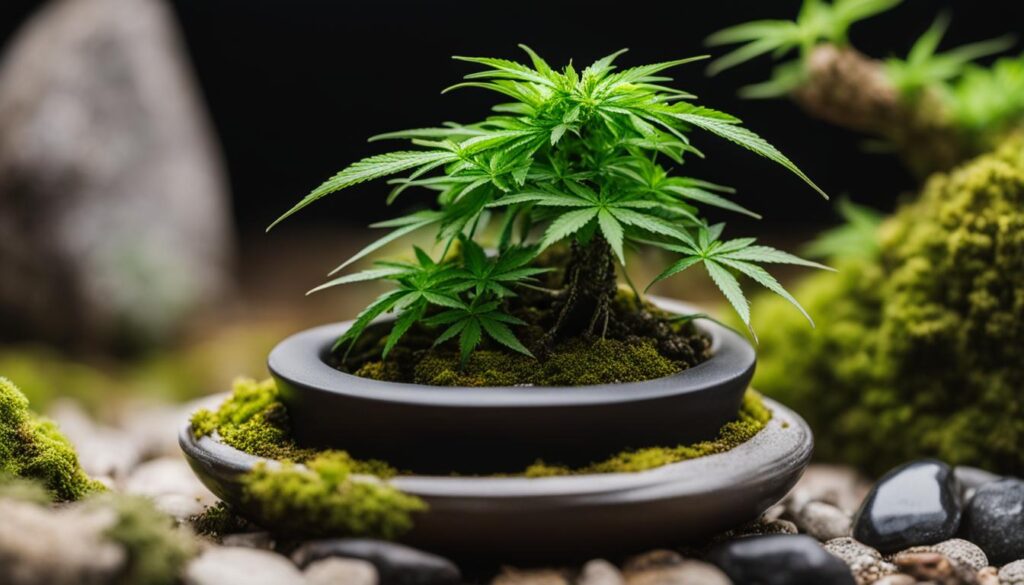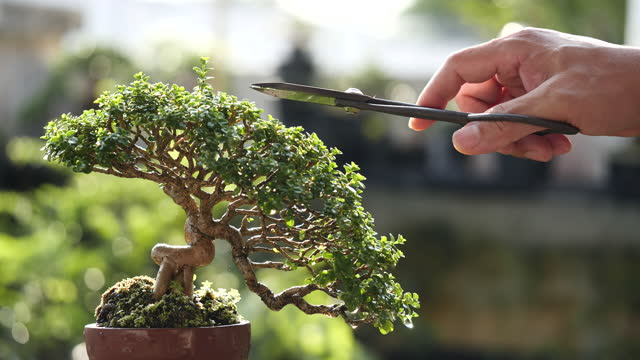Have you ever heard of cannabis bonsai? This unique growing technique combines the art of bonsai with the cultivation of cannabis plants, resulting in miniature masterpieces that are both beautiful and functional. In this comprehensive guide, we will explore the fascinating world of cannabis bonsai, from understanding the phenomenon to expert techniques and care tips.
Unlike traditional bonsai trees, it offers a unique twist on the art form. Imagine having a compact cannabis plant that fits perfectly on your windowsill or brings a touch of nature to your office desk. Cannabis bonsai allows you to enjoy the artistry of bonsai while also indulging in your love for Bonsai cultivation.
As a cannabis hobbyist, you may already be familiar with the basics of cultivation. However, growing it requires specific techniques and care to achieve the desired results. In the following sections, we will guide you through the entire process, covering everything from choosing the right strain to long-term cultivation and maintenance.
Understanding the Cannabis Bonsai Phenomenon
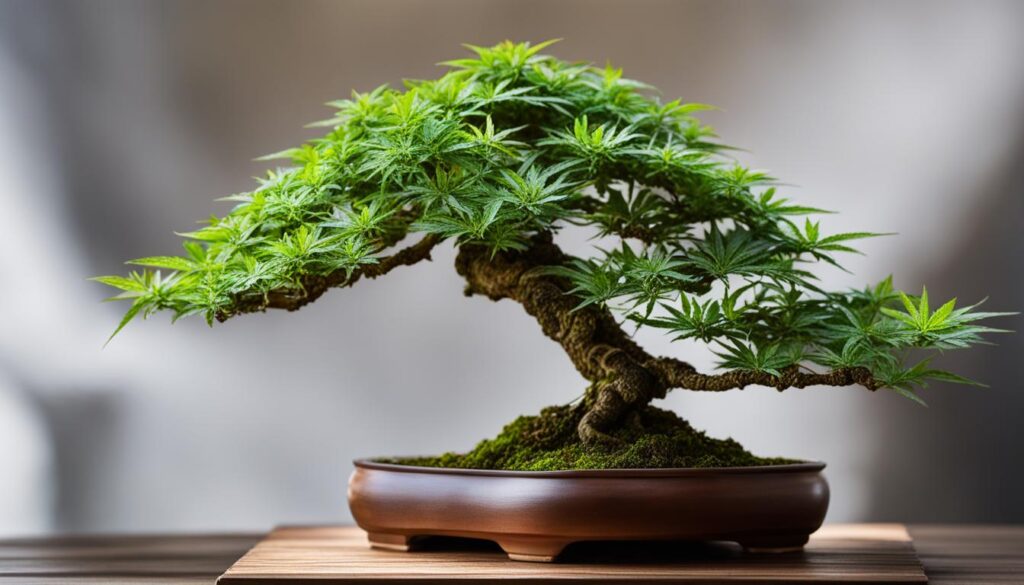
Before diving into the step-by-step process of growing cannabis bonsai, it’s important to understand the origins and significance of this unique phenomenon. Cannabis bonsai is not a new concept, but rather a modern adaptation of the ancient art of bonsai. Originating in China and refined by Japanese Buddhist monks, bonsai is the practice of growing miniaturized trees in small containers. This art form requires meticulous care and shaping to create miniature replicas of full-sized trees. Cannabis bonsai takes this concept and applies it to the cultivation of cannabis plants, resulting in compact, aesthetically pleasing specimens. By exploring the history and cultural significance of bonsai, we can better appreciate the artistry and dedication required to cultivate cannabis bonsai.
Ancient bonsai practices date back thousands of years, with evidence of miniature tree cultivation found in ancient Chinese artwork and writings. Buddhist monks in Japan further refined the art form, incorporating principles of Zen Buddhism and harmony with nature. Cannabis bonsai represents a modern fusion of this ancient tradition with the unique characteristics of the cannabis plant.
“Cannabis bonsai is a testament to the creativity and adaptability of growers who seek to combine artistry and horticulture. By cultivating cannabis plants in miniature form, enthusiasts are able to showcase their skills and create stunning living sculptures.” – Dr. Hiroshi Nakamura, Bonsai Expert
The cannabis bonsai phenomenon has gained popularity among cannabis enthusiasts and gardening hobbyists alike. The combination of the ancient bonsai practice with the unique features of the cannabis plant presents a captivating challenge and an opportunity to create truly one-of-a-kind creations.
In the next section, we will delve into the step-by-step approach to creating your own cannabis bonsai, from choosing the right strain to essential training techniques. By understanding the cultural heritage and significance of bonsai in conjunction with the artistry of cannabis cultivation, you will be equipped with the knowledge and inspiration to embark on your cannabis bonsai journey.
Creating Your Own Cannabis Bonsai: A Step-by-Step Approach
Cultivating your own cannabis bonsai tree is a rewarding and artistic endeavor. In this section, we will guide you through the step-by-step process of creating a healthy and beautiful cannabis bonsai masterpiece. It all begins with making the right choices from the start.
Choosing the Right Strain for Your Miniature Masterpiece
When choosing a strain for your cannabis bonsai, it’s important to select one that is suitable for compact growth. Look for strains with a short stature and compact structure. This will ensure that your bonsai remains manageable and visually appealing. Consider strains like Northern Lights, White Widow, or Hindu Kush, which have naturally compact growth patterns and are well-suited for bonsai cultivation.
Preparing and Positioning: Pots and Planting for Bonsai Success
The next step in creating your cannabis bonsai is preparing and positioning the pot for optimal growth. Choose a pot that is appropriate for the size of your bonsai tree. A shallow pot with excellent drainage is recommended to promote healthy root development. Select a well-draining bonsai soil mix and plant your cannabis bonsai carefully, ensuring the roots are properly positioned.
Position your cannabis bonsai in a location with adequate sunlight. Cannabis plants require at least 6 hours of direct sunlight each day. If outdoor cultivation is not possible, consider using grow lights or placing your bonsai near a sunny window.
Essential Training Techniques to Shape Your Cannabis Bonsai
Training and sculpting your cannabis bonsai is a crucial part of the bonsai cultivation process. These techniques allow you to shape and guide the growth of your tree, creating a visually stunning bonsai masterpiece. Some essential training techniques for your cannabis bonsai include:
- Low-Stress Training (LST): Gently bending and securing branches to encourage lateral growth and create a desired shape.
- Topping: Pruning the top growth of your cannabis bonsai to promote bushiness and compact growth.
- Pruning: Regularly pruning your bonsai to maintain its shape and remove any unwanted growth.
By implementing these essential training techniques, you can shape your cannabis bonsai into a work of art, showcasing your creativity and passion.
Expert Cannabis Bonsai Techniques

For those looking to take their cannabis bonsai to the next level, expert techniques can elevate your miniature masterpiece to new heights. In this section, we will explore advanced techniques used by experienced cannabis bonsai growers. These techniques require skill and precision to achieve desired results, allowing you to create truly unique and artistic creations that showcase your talent and dedication.
One of the key aspects of advanced bonsai training is mastering shaping techniques. This involves using methods such as wiring and bending to manipulate the growth of your cannabis bonsai. By carefully wiring branches and gently bending them, you can create elegant curves and intricate designs, giving your bonsai tree its own distinct character. This technique requires patience and attention to detail, but the results are well worth the effort.
Grafting and air layering are more complex techniques often used by experienced growers. Grafting involves joining two different cannabis plants together to create a single tree with unique characteristics. This method allows you to combine the desirable traits of different strains, resulting in a bonsai tree that is truly one-of-a-kind. Air layering, on the other hand, is a method of propagating new plants from existing branches, creating additional points of interest and complexity in your bonsai design.
By incorporating these expert cannabis bonsai techniques into your cultivation process, you can unlock endless creative possibilities. Experiment with different shaping techniques, try your hand at grafting, and explore the artistry of air layering. These advanced techniques will not only enhance the visual appeal of your cannabis bonsai but also provide a rewarding challenge for the dedicated hobbyist.
Cannabis Bonsai Care and Maintenance
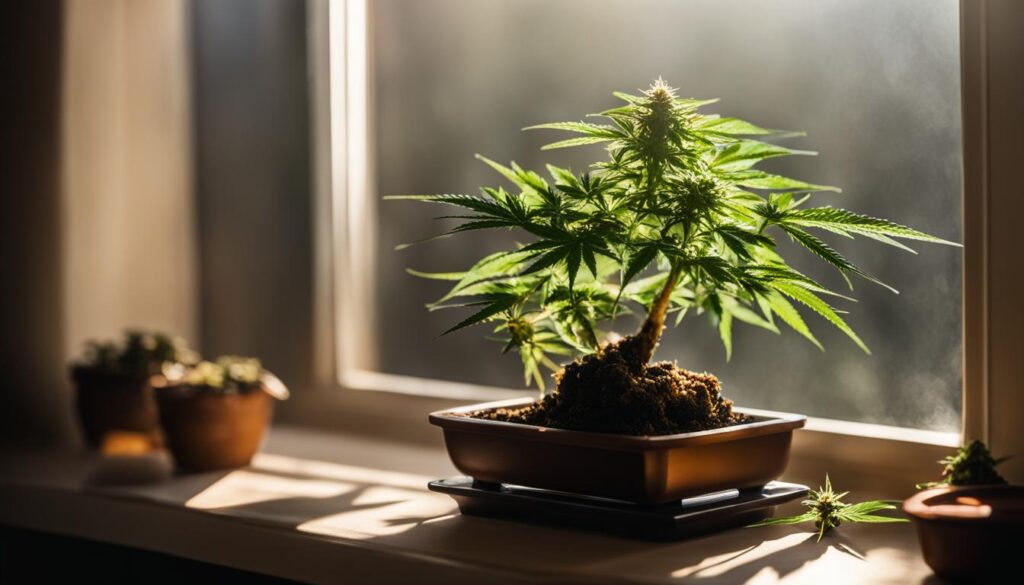
Successful cannabis bonsai cultivation goes beyond just shaping and training techniques. Proper care and maintenance are essential for the health and longevity of your miniature masterpiece. In this section, we will cover the key aspects of cannabis bonsai care, including lighting and temperature control, watering and feeding, and pruning practices for perfect aesthetics.
Proper Lighting and Temperature Control
Providing the right lighting and maintaining optimal temperature is crucial for the healthy growth of your cannabis bonsai. Cannabis plants require specific light intensities and durations at different stages of growth. For the vegetative stage, they thrive under a consistent 18-24 hours of light per day. During the flowering stage, reducing the light to 12 hours per day promotes bud development. Consider using LED grow lights for energy-efficient and customizable lighting.
In addition to lighting, maintaining the right temperature is vital. Keep your cannabis bonsai in a controlled environment with temperatures between 70-80°F (21-27°C) during the day and slightly cooler at night. Avoid drastic temperature fluctuations, as they can stress the plant and affect its overall health.
Watering and Feeding Your Compact Cannabis Plant
Proper watering and feeding are essential for the overall health and growth of your cannabis bonsai. The key is to strike a balance between providing enough moisture and avoiding waterlogging. Regularly check the moisture level of the soil by inserting your finger about an inch deep. Water the plant when the soil feels dry to the touch, but be cautious not to overwater.
When it comes to feeding your cannabis bonsai, choose a well-balanced fertilizer formulated specifically for cannabis plants. Follow the instructions on the fertilizer package, and adjust the feeding schedule based on the plant’s growth and nutrient requirements.
Pruning Practices for Perfect Cannabis Bonsai Aesthetics
Pruning plays a vital role in shaping and maintaining the aesthetics of your cannabis bonsai. Regular pruning helps control the plant’s size, improves airflow, and encourages new growth. When pruning, focus on removing dead or diseased branches, as well as any growth that disrupts the desired bonsai form.
Start pruning your cannabis bonsai when it is young to establish the desired shape. Use clean and sharp pruning shears or scissors to make clean cuts and minimize damage to the plant. Regularly inspect your bonsai for any signs of pests or diseases and take appropriate action if necessary.
| Aspect | Recommendation |
|---|---|
| Lighting | 18-24 hours of light during the vegetative stage 12 hours of light during the flowering stage |
| Temperature | 70-80°F (21-27°C) during the day, slightly cooler at night |
| Watering | Check soil moisture level regularly and water when dry Avoid waterlogging |
| Feeding | Use a well-balanced fertilizer for cannabis plants Follow instructions on the fertilizer package Adjust feeding schedule based on growth and nutrient requirements |
| Pruning | Regularly prune dead, diseased, or disruptive growth Start pruning when the bonsai is young Use clean and sharp pruning shears or scissors Inspect for pests and diseases regularly |
Cannabis Bonsai: Harvesting and Long-Term Cultivation
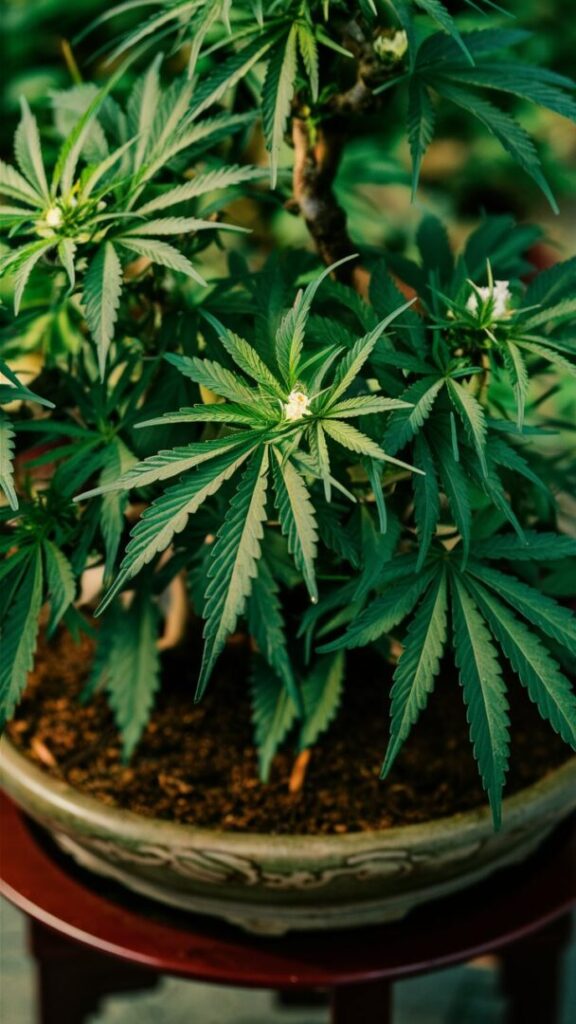
Congratulations on successfully growing and shaping your cannabis bonsai! Now, it’s time to dive into the process of harvesting and long-term cultivation to ensure the health and longevity of your miniature masterpiece.
Harvesting your cannabis bonsai requires careful timing to achieve the desired potency and flavor. The optimal time for harvest varies depending on the strain and your personal preferences. Look for the trichomes on the buds to become cloudy or amber in color, indicating that the cannabinoids are at their peak. Once you have determined the ideal time to harvest, carefully cut the branches and hang them upside down in a dark, well-ventilated area to dry. This curing process allows the buds to develop their full aroma and potency.
Long-term cultivation of your cannabis bonsai involves proper care and maintenance to ensure its health and vitality. Regular pruning is essential to remove any dead or yellowing leaves and promote healthy growth. Additionally, monitor the lighting and temperature conditions to create an optimal environment for your bonsai tree. Provide adequate light, either natural or artificial, and maintain a moderate temperature range of 70-85°F during the day and slightly cooler at night.
To maintain a healthy bonsai tree, remember to water it regularly but avoid overwatering, as excessive moisture can lead to root rot. Use well-draining soil specifically formulated for bonsai cultivation and feed your cannabis bonsai with a balanced fertilizer to provide the necessary nutrients for growth. Remember to monitor the overall health of your plant, keeping an eye out for any signs of pests or diseases.

Karen Phillips, Bonsai expert and blogger. Read more about me here

